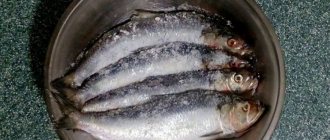Not all people have the opportunity to buy only fresh fish, but nutritionists recommend consuming this product at least twice a week. In addition, some varieties even reach the shelves of domestic stores only in frozen form. These are mackerel, hake, icefish, halibut, tuna, red snapper. Research by Norwegian scientists has shown that frozen fish is no different from fresh fish in terms of the composition of vitamins, minerals and other valuable substances. And so that the product does not spoil, it must be kept in the right conditions and at a certain temperature. We will tell you how long you can store fish in the freezer in our article. We will definitely focus on preparing the product for freezing and other important points.
How is fish frozen?
The tissues of this representative of the water element contain a lot of water. When properly frozen, this helps to increase the shelf life of fish. In this case, the temperature should be maintained at -18 °C without significant fluctuations in one direction or the other. It is important to ensure the required air humidity at the level of 85-95%.
The preservation of fish tissue and, accordingly, the quality of products is also affected by the speed of freezing. In the fast mode, small ice crystals form, which cover the carcass almost instantly, without destroying its structure.
Before long-term storage, already frozen fish is glazed using a special technology. The procedure is to cover the surface of the carcass with a small ice crust. It protects the fish from drying out and fat oxidation. When using the technology, each carcass is immersed for several seconds in ice water, the temperature of which is -2 °C or lower. Sometimes an antiseptic (polyvinyl alcohol) is additionally added to the water, which increases the shelf life of frozen products. If the technology is followed, the weight of the formed crust should be no more than 4% of the carcass weight.
How to prepare fish for storage in the freezer?
Only fresh product that has been previously cleaned, gutted and washed can be frozen. Before placing the fish in the freezer, it is recommended to store it in the refrigerator, preferably on a bed of ice. Be sure to get rid of the scales on the carcass and gut it. And there are several reasons for this:
- firstly, after defrosting, the fish will become softer and it will be more difficult to clean it;
- secondly, the insides contribute to the rancidity of tissues, which negatively affects the taste of the prepared dish;
- thirdly, it is recommended to immediately divide fresh fish into fillets and steaks, and then freeze them in portions.
The manipulations listed above will save time on cutting the carcass and wisely use the space in the freezer.
What to look for when choosing: useful tips
I recommend studying the following recommendations, they will help you buy a quality product in the store:
- If possible, purchase live fish, even if you do not plan to cook it right away. This way you will be sure of its quality and freshness before freezing.
- It is not always possible to buy a fresh product. Some species live far away, so delivering them alive is problematic. Pay attention to the variety; “overseas” ones must be frozen. Selling in a thawed form is prohibited; such a product cannot be re-frozen and eaten.
- It is better to buy frozen fish, vacuum packed. Such a package must have the date of catch and the expiration date after which the product cannot be consumed. The only thing you need to do is check the integrity of the vacuum film.
- Frozen products must have good appearance. The appearance of stains on the surface of the skin and mechanical damage is unacceptable.
- Never be shy to smell the product. Even after freezing, the fish should have its own smell, without any impurities.
- It is acceptable to sell certain types of fish in ice glaze, but its thickness should be no more than 5% of the total weight (according to GOST requirements).
Attention! If the original quality of the purchased product is high, you can keep the product in the freezer for a long time under certain conditions.
How to properly freeze fresh fish at home?
Before placing a product for storage in the freezer, you must complete the following steps:
- Cut the fish into fillets. To do this, take the fish by the tail and cut the meat from the spine, moving towards the head. Place the fillets in a freezer storage bag and remove as much air as possible. The polyethylene should fit the fish as tightly as possible.
- Before freezing whole cleaned fish, it must be immersed in ice-cold salted water. To do this, place the deep baking tray in the freezer for 5 minutes. Mix a teaspoon of salt in a liter of water. Place the fish in the brine and quickly place the carcass on a baking sheet in the freezer. After some time, repeat the procedure so that the resulting crust is thicker. Wrap frozen fish in special paper or place in a sealed bag.
- Be sure to write the date of freezing on the plastic.
If the technology is followed, fillets, steaks, and a whole carcass can stay in the freezer for quite a long time. The main thing is to ensure the required temperature conditions and monitor the shelf life of the fish. In this case, it will perfectly retain its appearance and taste.
Shelf life of ready-made meals at a catering establishment
06.01.2020
When we all come to a cafe, we want to have a tasty and safe lunch, we don’t think about what requirements apply to the distribution of dishes and culinary products in catering establishments.
What should be the temperature for serving ready-made dishes to a visitor, and their shelf life?
When served, hot dishes (soups, sauces, drinks) must have a temperature of no lower than 75 °C, main courses and side dishes - no lower than 65 °C, cold soups, drinks - no higher than 14 °C.
Ready-made first and second courses can be on a steam table or hot plate for no more than 2 - 3 hours from the moment of production.
Salads, vinaigrettes, gastronomic products, and other cold dishes and drinks must be displayed in portioned form in a refrigerated display counter and sold within one hour.
When selling hot catering products at a temperature not lower than 65 °C on a food warmer, hot plate, thermoses, gastronomic containers, heated containers for a buffet, the shelf life of dishes and culinary products should not exceed three hours from the moment of their production and packaging.
What prepared foods should not be left for the next day?
— salads, vinaigrettes, pates, jellies, jellied dishes, products with cream, etc.;
- especially perishable cold dishes (except for those types with expiration dates
prolonged in accordance with the established procedure);
— milk soups, cold soups, sweet soups, puree soups;
- boiled meat in portions for first courses, pancakes with meat and cottage cheese, chopped
products from meat, poultry, fish;
- sauces;
- omelettes;
- mashed potatoes, boiled pasta;
- Drinks of our own production.
In exceptional cases, with a mandatory note, the remaining food can be cooled and stored at a temperature of 4 ± 2 ° C for no more than 18 hours. Before sale, cooled food must be tasted and again subjected to heat treatment (boiling, frying on a stove or in an oven) with repeated tasting. The period for selling food after secondary heat treatment should not exceed 1 hour. Freshly prepared food should not be mixed with leftovers from the previous day.
In accordance with hygienic requirements (SanPiN 2.3.2.1324-03 “Hygienic requirements for shelf life and storage conditions of food products”), shelf life for ready-made culinary dishes has been established, subject to which safe food will be guaranteed:
Culinary products Time, hours Temperature
| Salads from raw vegetables and fruits: - without refilling — with dressings (mayonnaise, sauces) | 18 12 | (4+2)0С |
| Salads from raw vegetables with the addition of canned vegetables, eggs, etc.: - without refilling — with dressings (mayonnaise, sauces) | 18 6 | _ -//- _ |
| Salads from pickled, salted, pickled vegetables | 36 | -//- _ |
| Salads and vinaigrettes from boiled vegetables: - without dressing and adding salted vegetables — with dressings (mayonnaise, sauces) | 18 12 | _ _ _ -//-_ |
| Dishes of boiled, stewed, fried vegetables | 24 | -//- |
| Salads with the addition of meat, poultry, fish, smoked meats: - without refilling — with dressings (mayonnaise, sauces) | 18 12 | -//-_ |
| Side dishes: - boiled rice, boiled pasta, mashed potatoes - stewed vegetables - boiled, fried potatoes | 12 18 18 | -//- |
| Sauces and dressings for main courses | 48 | -//-__ |
Bon appetit and be healthy!
How long can you store fish in the freezer?
This question is perhaps the main one when it comes to preserving the quality of meat and seafood. After all, even properly frozen fish cannot be stored forever. Over time, it turns yellow as a result of fat oxidation and acquires a bitter taste. If we talk specifically about how long fish can be stored in the freezer, then the terms vary between 9-12 months. You can accurately name them taking into account the type of fish and the method of freezing it. But even if all conditions are met, you should be prepared for the fact that over time the taste of the product does not change for the better.
Shelf life of different types of fish
Sometimes housewives think about why frozen pink salmon can lie in the freezer for 6 months without changing the tissue structure, and anchovy becomes too soft just 2 months after thawing. The fact is that different fish tolerate the effects of low temperatures differently. In the table we present the terms of how long you can store different types of fish in the freezer.
| Fish names | Shelf life at temperature (months) | ||
| -18 °C | -25 °C | -32 °C | |
| Mullet, beluga, catfish, pike, whitefish, carp | 8 | 10 | 12 |
| Flounder, halibut, salmon, cod | 6 | 7,5 | 9 |
| Butter, horse mackerel, greenling | 5 | 6 | 7,5 |
| Mackerel, tuna, Atlantic herring, ocean mackerel | 4 | 5 | 6 |
| Caspian and Baltic sprat, herring (Norwegian and any other except Atlantic), skipjack tuna | 3 | 4 | 5 |
| Anchovy, capelin, mackerel (except oceanic) | 2 | 2,5 | 3 |
How to defrost fish before eating?
Before preparing any fish dish, the carcass must first be removed from the freezer and placed on the top shelf of the refrigerator. This method will ensure gradual thawing, which will not disturb the tissue structure. As a result, freshly frozen pink salmon will be as tasty as freshly caught salmon.
Defrosting and re-freezing fish is not allowed. No matter how slow the thawing is, at this time there is a significant increase in temperature, the ice crystals are destroyed, the tissues soften and begin to ooze. If you freeze again in this state, an ice crust will form inside the carcass. As a result, the tissue of the fish will be completely destroyed, it will lose its appearance and taste.
Signs of a spoiled product
A quality product has a natural color and a clean surface . After thawing and cooking, taste and smell are assessed. They must match the type of fish.
Defects in chilled and frozen products are determined by the quality of raw materials and their processing technology. If something in the technical process is disrupted, foreign odors appear, color, appearance and consistency change.
You definitely shouldn’t buy fish if you have the following signs::
- dark or reddish-brown surface;
- mold on scales;
- smell of petroleum products, putrid, warehouse, stale, garlicky.
Fish should not be eaten if, during/after cooking, its consistency has become tough, fibrous, flabby or structureless, or the muscle tissue of the carcass has become flaky.










